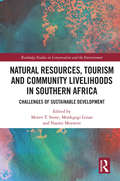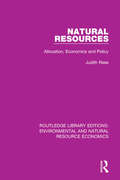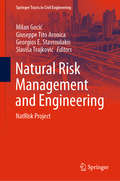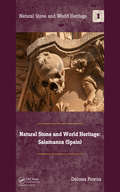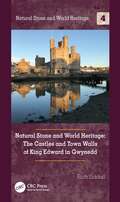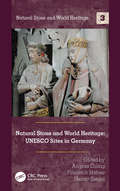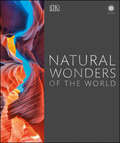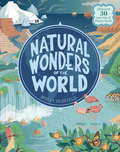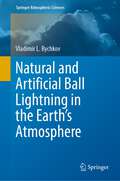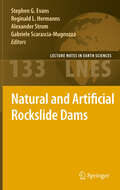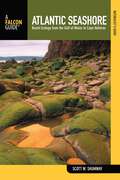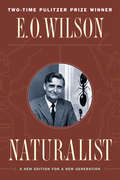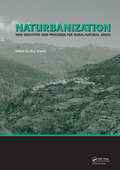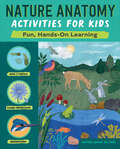- Table View
- List View
Natural Resources, Tourism and Community Livelihoods in Southern Africa: Challenges of Sustainable Development (Routledge Studies in Conservation and the Environment)
by Naomi Moswete Moren T. Stone Monkgogi LenaoThis book examines the connections between natural resources, tourism and community livelihood practices in Southern Africa, highlighting the successes and constraints experienced over the last 50 years. Questioning how natural resources, tourism and community livelihoods relations can positively contribute towards development efforts, this book adopts an interdisciplinary approach to understand socio-ecological systems that characterize the dynamics for sustainable development. It explores the history of conservation and natural resource management in Southern Africa and traces the development and growth of nature-based tourism. Boasting a wide range of tourism landscapes, including national parks, wetlands, forests and oceans, the book draws on case studies from a variety of Southern African countries, including Botswana, Namibia and South Africa, and considers the political challenges for implementing policies and practices. Furthermore, it analyses broader issues such as the impact of climate change, human–wildlife co-existence and resulting conflicts, poor access to funding and poverty in local communities. The book argues that the links between conservation and livelihoods can be best understood by considering the different approaches to reconciling the demands of conservation and livelihoods that have evolved over the past decades. Containing contributions from natural and social sciences the book provides guidance for practitioners and policymakers to continue to shape policies and practices that are in line with the key tenets of sustainable development. It will also be of great interest to students and scholars researching Southern Africa, sustainable tourism and conservation.
Natural Resources: Allocation, Economics and Policy (Routledge Library Editions: Environmental and Natural Resource Economics)
by Judith ReesIn this book, first published in 1990, Judith Rees considers the spatial distribution of resource availability, development and consumption, and the distribution of resource-generated wealth and welfare. Showing that there are no simple answers, she analyses the complex interactions between economic forces, administrative structures and political institutions. This well-structured text is essential reading for upper-level students in geography, environmental planning, economics and resource management.
Natural Resources: Neither Curse nor Destiny
by Daniel Lederman William F. Maloney'Natural Resources: Neither Course nor Destiny' brings together a variety of analytical perspectives, ranging from econometric analyses of economic growth to historical studies of successful development experiences in countries with abundant natural resources. The evidence suggests that natural resources are neither a curse nor destiny. Natural resources can actually spur economic development when combined with the accumulation of knowledge for economic innovation. Furthermore, natural resource abundance need not be the only determinant of the structure of trade in developing countries. In fact, the accumulation of knowledge, infrastructure, and the quality of governance all seem to determine not only what countries produce and export, but also how firms and workers produce any good.
Natural Resources: Quality and Quantity
by James J. Parsons S. V. Ciriacy-WantrupThis title is part of UC Press's Voices Revived program, which commemorates University of California Press’s mission to seek out and cultivate the brightest minds and give them voice, reach, and impact. Drawing on a backlist dating to 1893, Voices Revived makes high-quality, peer-reviewed scholarship accessible once again using print-on-demand technology. This title was originally published in 1967.
Natural Risk Management and Engineering: NatRisk Project (Springer Tracts in Civil Engineering)
by Milan Gocić Giuseppe Tito Aronica Georgios E. Stavroulakis Slaviša TrajkovićThis book summarizes the research being pursued as part of the Erasmus+ CBHE KA2 project entitled "Development of master curricula for natural disasters risk management in Western Balkan countries” (NatRisk), which aims to educate experts on the prevention and management of natural disasters in the Western Balkan region in line with national and EU policies. The project has successfully developed and implemented master curricula and educational training in the field of natural disasters risk management, and a methodology for the identification and prevention of natural disasters. Consisting of 11 chapters, the book analyzes and discusses topics such as risk assessment tools and quality methods, the different approaches for civil-military collaboration, natural disasters risk management in Bosnia and Herzegovina, leadership models for managing crises resulting from natural disasters, natural disasters in industrial areas, natural risk management in geotechnics, flood risk modeling, adaptive neuro-fuzzy inference models for flood prediction, collapse prediction of masonry arches, an algorithm for fire truck dispatch in emergency situations, and processing drought data in a GIS environment.
Natural Satellites: The Book of Moons
by Ron MillerFor centuries, astronomers have placed a special importance on the other planets of the solar system. But with the advent of spacecraft and the tremendous missions undertaken by the Voyager and Cassini probes, astronomers have discovered that the natural satellites of the planets—the solar system's moons—are some of the most extraordinary places imaginable. There are moons with towering geysers, erupting volcanoes, and subterranean oceans of warm, mineral-rich water. Some of the highest mountains and deepest canyons can be found on moons. There are moons that have shattered into pieces and then reassembled. There is even a moon where it rains rocket fuel. Recently, scientists have turned to moons for answers in their investigations of the origins of the solar system and the evolution of life on our own planet. Featuring full-color, scientifically accurate illustrations by NASA artist Ron Miller, Natural Satellites: The Book of Moons chronicles these investigations and the questions we have yet to answer in our exploration of the solar system's moons.
Natural Stone and World Heritage: Salamanca (Spain) (Natural Stone and World Heritage)
by Dolores PereiraHeritage stones are those stones that have been used for many years, even centuries, to build the historic buildings and monuments of places around the world. Some of these stones are still being used for construction, but others are no longer used, either because quarries were exhausted or closed or because architects and constructors do not know about their particularities and importance. Several scientific papers discuss many of these stones, and a number of papers are currently being prepared, but this book is the first to emphasize the importance and significance of natural stone in the construction of a city, Salamanca, recognized as a World Heritage Site by UNESCO since 1988. In light of this recognition, Salamanca has a duty to preserve all historic buildings that make up the city by restoring those that are starting to deteriorate centuries after their construction. <P><P>This book describes the buildings, the stones (all quarried centuries ago in the surrounding area), and the stone quarries, some of them inactive for many years, but that should still allow extraction of blocks on demand to restore and replace damaged specimens in the buildings, preserving the very character that saw the city receive recognition by UNESCO in the first place. There are many other places around the world that should follow this initiative and disseminate the importance of their heritage stones. This book will be of interest to professionals and academics in Geology, Engineering, architectural and artistic work in stone, both construction and conservation, but also to the general public.
Natural Stone and World Heritage: The Castles and Town Walls of King Edward in Gwynedd (Natural Stone and World Heritage)
by Ruth SiddallThis book is about the stone used to build the castles of Edward I in North West Wales. It provides a description of the available geological resources and the building materials used in the construction of Caernarfon, Conwy, Harlech and Beaumaris Castles. It takes a broad view of this subject, placing the stone used in the castles in the context of both earlier and later buildings across the region of study, from the Neolithic up until the present day. The book will serve as a useful source book for geologists, archaeologists, architects, representatives of the natural stone industry, historians and cultural heritage management professionals specifically and for academic and non-academic communities, travellers and tourism industry operators in general.
Natural Stone and World Heritage: UNESCO Sites in Germany (Natural Stone and World Heritage)
by Angela Ehling Friedrich Häfner Heiner SiedelThere are many UNESCO World Heritage Sites in Germany. Most of them are built with natural stones. These sites are commonly presented to the public with a lot of information regarding historical, cultural and artistic aspects. Mostly, there is no focus on the main building material if it concerns natural stones. This work aims to show that it is precisely the natural stone that lends the sites their distinctive character. The used stones demonstrate the context and the interaction with the geology of the surrounding countryside as well as possibilities of transport and treatment. They reflect the culture and society at the time of the building phases. The second part of the work presents the most important stones that were used at these sites, along with their occurrences, aspects of quarrying in historical times and of course their petrographical, mineralogical and technical features. It is shown how these features influence the weathering of the stones and how restoration of stones is carried out. The book will serve as a useful source book for geologists, archaeologists, architects, representatives of the natural stone industry, historians and cultural heritage management professionals specifically, and for academic and nonacademic communities, travelers and tourism industry operators in general.
Natural Visions: The Power of Images in American Environmental Reform
by Finis DunawayWalden Pond. The Grand Canyon.Yosemite National Park. Throughout the twentieth century, photographers and filmmakers created unforgettable images of these and other American natural treasures. Many of these images, including the work of Ansel Adams, continue to occupy a prominent place in the American imagination. Making these representations, though, was more than a purely aesthetic project. In fact, portraying majestic scenes and threatened places galvanized concern for the environment and its protection. Natural Visions documents through images the history of environmental reform from the Progressive era to the first Earth Day celebration in 1970, showing the crucial role the camera played in the development of the conservation movement. In Natural Visions, Finis Dunaway tells the story of how visual imagery—such as wilderness photographs, New Deal documentary films, and Sierra Club coffee-table books—shaped modern perceptions of the natural world. By examining the relationship between the camera and environmental politics through detailed studies of key artists and activists, Dunaway captures the emotional and spiritual meaning that became associated with the American landscape. Throughout the book, he reveals how photographers and filmmakers adapted longstanding traditions in American culture—the Puritan jeremiad, the romantic sublime, and the frontier myth—to literally picture nature as a place of grace for the individual and the nation. Beautifully illustrated with photographs by Ansel Adams, Eliot Porter, and a host of other artists, Natural Visions will appeal to a wide range of readers interested in American cultural history, the visual arts, and environmentalism.
Natural Wonders of the World (DK Wonders of the World)
by DKDiscover which of Earth's wonders should definitely make it onto your bucket list with this unparalleled survey of the world's natural treasures.Landscape photography combines 3D terrain models and other explanatory artworks to reveal what lies beneath the surface and how features form. To complete the all-around picture, the plants and animals that inhabit the environments are also included, making Natural Wonders of the World a celebration of our world and the most accessible-ever guide to Earth's geological processes and features.In this book about the world, you will find:-Photography of animals, nature, and sites from across the globe to create a visual celebration of our planet's natural beauty.-Artworks and digital terrain models, constructed from satellite and other data explain how features were formed and reveal their hidden sides.-Detailed chapters on different continents worldwide- including Asia, Europe, North America, and Africa. -Facts, statistics, maps, and explanations about our planet&’s plants and animals. As well as information about rainforests, glaciers, and oceans. Also, explore extreme weather conditions such as Cyclones, Thunderstorms, Tornadoes, sandstorms, and dust storms in Natural wonders of the World. This book is organized continent by continent and includes the greatest natural wonders from around the world, from the Grand Canyon to the Amazon Rainforest and the Himalayas to the Antarctic Ice-sheet! Purchase the perfect gift for those who want to tick off their bucket list locations or for those who want to learn more about the planet and the incredible wonders it has to offer.
Natural Wonders of the World: Discover 30 marvels of Planet Earth
by Molly OldfieldSet off on a journey of discovery in this beautiful photographic celebration of the natural world.From firefly squid glowing against the night sky in Japan to a Mexican cave filled with the largest crystals ever found, you'll discover the stories and science behind these wonders, the threats they now face and the efforts taking place to save them. How did the Grand Canyon come to be? Where is the most electric place on Earth? And what can we do to protect the Great Barrier Reef?Both a stunning tour of the planet we call home, and an overview of some of the biggest environmental problems of today, Natural Wonders of the World is the perfect gift for anyone who loves exploring the great outdoors.
Natural and Artificial Ball Lightning in the Earth’s Atmosphere (Springer Atmospheric Sciences)
by Vladimir L. BychkovThe monograph is devoted to ball lightning (BL) observed in natural conditions in the air and artificial BL, long-lived luminous formations (LLF), usually obtained in laboratories experimentally. Joint consideration of artificial and natural BL emphasizes the need for a comprehensive analysis of such complex objects. It is the description of the study of the properties of artificial BL and LLF in the end of 20th and 21st centuries that allows the reader to better understand what and how can be experimentally simulated.
Natural and Artificial Rockslide Dams
by Reginald L. Hermanns Alexander Strom Stephen G. Evans Gabriele Scarascia-MugnozzaIn the last one hundred years, a number of catastrophic events associated with rockslide dam formation and failure have occurred in the mountain regions of the world. This book presents a global view of the formation, characteristics and behaviour of natural and artificial rockslide dams. Chapters include a comprehensive state-of-the-art review of our global understanding natural and artificial rockslide dams, overviews of approaches to rockslide dam risk mitigation, regional studies of rockslide dams in India, Nepal, China, Pakistan, New Zealand, and Argentina. Rockslide dams associated with large-scale instability of volcanoes are also examined. Detailed case histories of well-known historic and prehistoric rockslide dams provide examples of investigations of rockslide dam behaviour, stability, and characteristics. The formation and behaviour of rockslide-dammed lakes ("Quake Lakes") formed during the 2008 Wenchuan Earthquake, China are also comprehensively summarised. The formation, sedimentology and stability of rockslide dams is examined in several analytical papers. An analysis of break-out floods from volcanogenic lakes and hydrological methods of estimating break-out flood magnitude and behavior are reviewed. The use of remote sensing data in rockslide-dammed lake characterisation is explored and a new approach to the classification of rockslide dams is introduced. Finally, a unique section of the book summarises Russian and Kyrgyz experience with blast-fill dam construction in two papers by leading authorities on the technology. The volume contains 24 papers by 50 authors from 16 countries including most of the recognised world authorities on the subject.
Natural and Cultural Diversity in the Himalaya (SpringerBriefs in Environmental Science)
by Vishwambhar Prasad SatiThe Himalaya is the new folded mountain system – the tallest and the youngest in the world. It has a rich diversity – natural and cultural, and diversity in all walks of life. Most of its uniqueness is unknown because of its remoteness. Even, the native people are not aware of them. This book aims to describe the uniqueness of the Central Himalaya in terms of its natural and cultural diversity in detail. Supported by original figures and primary data, this book is empirically tested. It is mainly based on observation and participation and the use of a qualitative approach. Although lots of work has been carried out on the various aspects of the Himalayan region yet, a detailed description of the natural and cultural diversity is yet to be done. This book steps forward to elaborate on some of the unique natural and cultural features of the Central Himalaya, which are worthy to be known about. It contains a total of 10 chapters. Four chapters are devoted to natural diversity and four chapters comprise cultural diversity. Besides, the introduction and conclusions are the first and the last chapters of the book, respectively. The book is the first of its kind and will be useful to all stakeholders – students of all standards, research scholars, academicians, policymakers, native people, tourists, and the general public.
Natural and Engineered Solutions for Drinking Water Supplies: Lessons from the Northeastern United States and Directions for Global Watershed Management
by Mark S. Ashton Emily Alcott Bradford S. GentryIlluminating opportunities to develop a more integrated approach to municipal water system design, Natural and Engineered Solutions for Drinking Water Supplies: Lessons from the Northeastern United States and Directions for Global Watershed Management explores critical factors in the decision-making processes for municipal water system delivery. Th
Natural and Enhanced Attenuation of Contaminants in Soils, Second Edition
by Raymond N. Yong Catherine N. MulliganNatural attenuation has become an effective and low-cost alternative to more expensive engineered remediation. This new edition updates the principles and fundamentals of natural attenuation of contaminants with a broader view of the field. It includes new methods for evaluating natural attenuation mechanisms and microbial activity at the lab and field scales. Case studies, actual treatments and protocols, theoretical processes, case studies, numerical models, and legal aspects in the natural attenuation of organic and inorganic contaminants are examined. Challenges and future directions for the implementation of natural attenuation and enhanced remediation techniques are also considered.
Naturalist 25th Anniversary Edition
by Edward O. WilsonEdward O. Wilson – University Professor at Harvard, winner of two Pulitzer prizes, eloquent champion of biodiversity – is arguably one of the most important thinkers of the twentieth century. His career represents both a blueprint and a challenge to those who seek to explore the frontiers of scientific understanding. Yet, until now, little has been told of his life and of the important events that have shaped his thought.In Naturalist, Wilson describes for the first time both his growth as a scientist and the evolution of the science he has helped define. He traces the trajectory of his life – from a childhood spent exploring the Gulf Coast of Alabama and Florida to life as a tenured professor at Harvard – detailing how his youthful fascination with nature blossomed into a lifelong calling. He recounts with drama and wit the adventures of his days as a student at the University of Alabama and his four decades at Harvard University, where he has achieved renown as both teacher and researcher.As the narrative of Wilson's life unfolds, the reader is treated to an inside look at the origin and development of ideas that guide today's biological research. Theories that are now widely accepted in the scientific world were once untested hypotheses emerging from one man's broad-gauged studies. Throughout Naturalist, we see Wilson's mind and energies constantly striving to help establish many of the central principles of the field of evolutionary biology.The story of Wilson's life provides fascinating insights into the making of a scientist, and a valuable look at some of the most thought-provoking ideas of our time.
Naturalist's Guide to the Atlantic Seashore: Beach Ecology From The Gulf Of Maine To Cape Hatteras (Naturalist's Guide Series)
by Scott ShumwayFrom the North Carolina's Outer Banks to Maine's rocky coast, this comprehensive guidebook covers the ecology, wildlife, plants and ocean creatures in full-color photographs and vivid detail. No other book includes all of the plants, animals, and terrain along this stretch of coastline, making this a must-have for anyone who lives or recreates near the Atlantic. The diverse habitats of the seashore, from the Rocky Shores to Sandy Beaches, Estuaries, Tidal Flats, Salt Marshes, Seagrass Meadows, and the Open Ocean are explored in detail in this user-friendly guide and natural history. The easy-to-use layout, comprehensive index, water-resistant cover and guaranteed binding make this a beautiful volume of natural history and biodiversity.Scott W. Shumway is a professor of biology at Wheaton College. He lives in Westborough, Massachusetts.
Naturalist: Conservation And Development In The Maya Forest Of Belize (Naturalist Directory And Almanac Ser.)
by Edward O. WilsonEdward O. Wilson -- University Professor at Harvard, winner of two Pulitzer prizes, eloquent champion of biodiversity -- is arguably one of the most important thinkers of the twentieth century. His career represents both a blueprint and a challenge to those who seek to explore the frontiers of scientific understanding. Yet, until now, little has been told of his life and of the important events that have shaped his thought.In Naturalist, Wilson describes for the first time both his growth as a scientist and the evolution of the science he has helped define. He traces the trajectory of his life -- from a childhood spent exploring the Gulf Coast of Alabama and Florida to life as a tenured professor at Harvard -- detailing how his youthful fascination with nature blossomed into a lifelong calling. He recounts with drama and wit the adventures of his days as a student at the University of Alabama and his four decades at Harvard University, where he has achieved renown as both teacher and researcher.As the narrative of Wilson's life unfolds, the reader is treated to an inside look at the origin and development of ideas that guide today's biological research. Theories that are now widely accepted in the scientific world were once untested hypotheses emerging from one mans's broad-gauged studies. Throughout Naturalist, we see Wilson's mind and energies constantly striving to help establish many of the central principles of the field of evolutionary biology.The story of Wilson's life provides fascinating insights into the making of a scientist, and a valuable look at some of the most thought-provoking ideas of our time.
Naturally Challenged: Contested Perceptions and Practices in Urban Green Spaces (Cities and Nature)
by Nicola Dempsey Julian DobsonThis book aims to understand how the wellbeing benefits of urban green space (UGS) are analysed and valued and why they are interpreted and translated into action or inaction, into ‘success’ and/or ‘failure’. The provision, care and use of natural landscapes in urban settings (e.g. parks, woodland, nature reserves, riverbanks) are under-researched in academia and under-resourced in practice. Our growing knowledge of the benefits of natural urban spaces for wellbeing contrasts with asset management approaches in practice that view public green spaces as liabilities. Why is there a mismatch between what we know about urban green space and what we do in practice? What makes some UGS more ‘successful’ than others? And who decides on this measure of ‘success’ and how is this constituted? This book sets out to answer these and related questions by exploring a range of approaches to designing, planning and managing different natural landscapes in urban settings.
Naturbanization: New identities and processes for rural-natural areas
by M. J. PradosAs the growth of the worlds population requires the continued search for residential space, the urbanization of natural lands is an inevitable process, but that process does not have to be one that is accomplished without regard for environmental quality. This book presents the unique perspective of naturbanization, the urbanization of protected a
Nature
by Noel CastreeExploring the shifting ways in which geographers have studied nature, this book emphasizes the relationships and differences between human geography, physical geography and resource and hazards geography. The first to consider the topic of nature in modern geography as a whole, this distinctive text looks at all its major meanings, from the human body and psyche through to the non-human world, and develops the argument that student readers should abandon the idea of knowing what nature is in favour of a close scrutiny of what agendas lie behind competing conceptions of it. It deals with, amongst others, the following areas: the idea of nature the 'nature' of geography de-naturalization and re-naturalization after-nature. As everything from global warming to GM foods becomes headline news, the use and abuse of nature is on the agenda as never before. Synthesizing a wealth of diverse and complex information, this text makes the significant theories, debates and information on nature accessible to students of geography, environmental studies, sociology, and cultural studies.
Nature All Around Us: A Guide to Urban Ecology
by Beatrix Beisner, Christian Messier, and Luc-Alain GiraldeauIt’s easy to stand in awe of a city’s impressive skyline, marveling at its buildings reaching for the clouds and its vast network of roadways and train lines crisscrossing in every direction. It can often seem like everything in a city is man-made, all concrete, steel, and glass. But even the asphalt jungle is not all asphalt—a sidewalk’s cracks are filled with nature, if we know where and how to look. To aid us in this quest is Nature All Around Us, which will help us to recognize (and look after) the natural world we traipse through in our daily lives. Nature All Around Us uses the familiar—such as summer Sundays humming with lawn mowers, gray squirrels foraging in planters, and flocks of pigeons—in order to introduce basic ecological concepts. In twenty-five short chapters organized by scale, from the home to the neighborhood to the city at large, it offers a subtle and entertaining education in ecology sure to inspire appreciation and ultimately stewardship of the environment. Various ecological concepts that any urban dweller might encounter are approachably examined, from understanding why a squirrel might act aggressively towards its neighbor to how nutrients and energy contained within a discarded apple core are recycled back into the food chain. Streaming through the work is an introduction to basic ecology, including the dangers of invasive species and the crucial role played by plants and trees in maintaining air quality. Taken as a whole, Nature All Around Us is an unprecedented field guide to the ecology of the urban environment that invites us to look at our towns, cities, and even our backyards through the eyes of an ecologist. It is an entertaining, educational, and inspiring glimpse into nature in seemingly unnatural settings, a reminder that we don’t have to trek into the wild to see nature—we just have to open our eyes.
Nature Anatomy Activities for Kids: Fun, Hands-On Learning (Anatomy Activities for Kids)
by Kristine BrownThink like a scientist and search like an explorer with this illustrated nature guide for kids ages 8 to 12Get ready to explore the sky above, the ground below, and all the plants and creatures in between! Made just for kids, this nature anatomy book teaches you about the incredible forces and living things that exist in nature.You'll dig in to tons of different topics—from naming the layers of the atmosphere to learning the parts of a flower—and try out fun activities like creating a mini cloud and raising a tadpole. As you explore the natural world around you, you'll become a real scientist by asking questions, imagining outcomes, testing your ideas, and then writing down what you discover.Nature Anatomy Activities for Kids includes:5 Subjects, 20 lessons—Dive in to different chapters for the earth, the sky, water, plants, and animals. Every chapter includes multiple lessons about the topic, with a new activity and a journal prompt for each.Journal like a scientist—Use your own blank journal to answer prompts and take notes so you can write and draw everything you observe or note any questions you want to find an answer for.Detailed illustrations—Colorful pictures and diagrams make this nature anatomy book fun to use and get kids excited about the anatomy of plants, animals, ecosystems, and landscapes.Get outside and explore with this book of nature anatomy activities that opens up a whole new world of learning.
